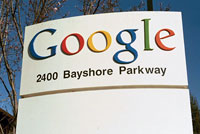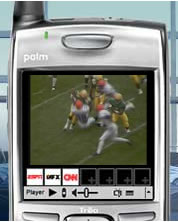 Google is converting its Californian headquarters to run partly on solar power, creating the largest solar installation on any corporate campus in the United States.
Google is converting its Californian headquarters to run partly on solar power, creating the largest solar installation on any corporate campus in the United States.
The Internet search giant has said that its jumbo-sized solar project will eventually deliver nearly a third of the power at its 1-million-square-foot campus in Mountain View, near San Francisco.
Kitting out the campus will require the installation of more than 9,200 solar panels on high-tech offices known as the “Googleplex.”
Expected to be up and running by next Spring, the panels should be able to generate about 1.6 megawatts of electricity – enough power to supply about 1,000 homes.
 Google haven’t disclosed the costs of the project, but it’s unlikely to cause much of a dent in the pockets of a company reputed to have nearly $10 billion in the corporate coffers.
Google haven’t disclosed the costs of the project, but it’s unlikely to cause much of a dent in the pockets of a company reputed to have nearly $10 billion in the corporate coffers.
With about a trillion hard drives purring away and Borg-like billions of PCs busily indexing this interweb thing, we imagine Google’s energy costs must be sky high, but David Radcliffe, Google’s vice president of real estate, reckoned that anticipated savings from future energy bills should pay back the solar project’s costs in five to 10 years.
“We hope corporate America is paying attention. We want to see a lot of copycats” of this project, he commented.
Nice one, Google.
 Apple has continued to increase the number of iPods they’re selling. Their latest quarterly results show that they grown the 8.11m iPods they sold in the previous quarter to 8.73m this quarter, beyond market expectations. The quarter that is reporting didn’t change or introduce any new iPods.
Apple has continued to increase the number of iPods they’re selling. Their latest quarterly results show that they grown the 8.11m iPods they sold in the previous quarter to 8.73m this quarter, beyond market expectations. The quarter that is reporting didn’t change or introduce any new iPods. Logitech has announced that it is buying Slim Devices for $10m cash plus a possible performance-based payment tied to certain revenue targets. The news came on the same day as their best-ever Q2 sales, which reached $502m.
Logitech has announced that it is buying Slim Devices for $10m cash plus a possible performance-based payment tied to certain revenue targets. The news came on the same day as their best-ever Q2 sales, which reached $502m. Orange and Microsoft have joined together to offer Instant Messaging (IM) connectivity between computers and mobile phones, claiming it’s a first.
Orange and Microsoft have joined together to offer Instant Messaging (IM) connectivity between computers and mobile phones, claiming it’s a first. Sony and Sky are tying up to show the UK’s first HD advert tonight.
Sony and Sky are tying up to show the UK’s first HD advert tonight. Shot over 10 days and with a crew of 250 people, the paint was mixed on site by 20 people. The clear up took 5 days and 60 people.
Shot over 10 days and with a crew of 250 people, the paint was mixed on site by 20 people. The clear up took 5 days and 60 people. The launch of this first HD ad follows a major marketing agreement between Sky and Sony to promote HD.
The launch of this first HD ad follows a major marketing agreement between Sky and Sony to promote HD. Pure Digital Technologies has announced a cheapo camcorder that can upload movies to video sharing Web sites like Google Video with a single click.
Pure Digital Technologies has announced a cheapo camcorder that can upload movies to video sharing Web sites like Google Video with a single click. Allen Weiner, an analyst with market tracker Gartner, reckoned Pure Digital were on to a winner, describing the pint-size camcorder as “simple, but also revolutionary.”
Allen Weiner, an analyst with market tracker Gartner, reckoned Pure Digital were on to a winner, describing the pint-size camcorder as “simple, but also revolutionary.” Unhappy with the inaccuracies of the online encyclopaedia he set up, Wikipedia co-founder Larry Sanger has announced that he will be launching an alternative to the free online reference this week.
Unhappy with the inaccuracies of the online encyclopaedia he set up, Wikipedia co-founder Larry Sanger has announced that he will be launching an alternative to the free online reference this week. Such is the explosive growth of the site, this figure represents a whopping 162 percent rise from the same period last year.
Such is the explosive growth of the site, this figure represents a whopping 162 percent rise from the same period last year. Sling is developing software to play their video on Symbian mobile phones.
Sling is developing software to play their video on Symbian mobile phones. The current Pocket PC version of the SlingPlayer Mobile software application is currently available only in the U.S. and Canada. The Symbian OS version will be made available in select European and Asian countries during Q4 and will extend availability to the US shortly thereafter.
The current Pocket PC version of the SlingPlayer Mobile software application is currently available only in the U.S. and Canada. The Symbian OS version will be made available in select European and Asian countries during Q4 and will extend availability to the US shortly thereafter. A new survey of over 1,000 early adopters and mobile phone business users discovered little enthusiasm for mobile video but a keen interest in using handsets as navigation aids.
A new survey of over 1,000 early adopters and mobile phone business users discovered little enthusiasm for mobile video but a keen interest in using handsets as navigation aids. Commenting on the low uptake of value-added 3G services, Chamberlain suggested that customers were reluctant to part with their hard-earned just to watch juddery little video clips of “yesterday’s ballgame” on the squinty displays of smartphones.
Commenting on the low uptake of value-added 3G services, Chamberlain suggested that customers were reluctant to part with their hard-earned just to watch juddery little video clips of “yesterday’s ballgame” on the squinty displays of smartphones. If the findings of the In-Stat survey prove to be representative of the population as a whole, it looks like mobile phone carriers are going to have to shuffle around their ranges of phones currently being offered, and give GPS-enabled phones a bigger push (or look to include more mobile navigation apps like Google Maps).
If the findings of the In-Stat survey prove to be representative of the population as a whole, it looks like mobile phone carriers are going to have to shuffle around their ranges of phones currently being offered, and give GPS-enabled phones a bigger push (or look to include more mobile navigation apps like Google Maps).